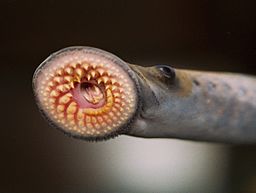Hydro Seasonal Rate Cancellation Implementation Date Set
As previously reported, eliminating the Hydro One Networks Inc. seasonal distribution rate class (approximately 148,000 customers) will move those customers into one of three Hydro One residential rate classes, according to their density, in order to ensure that the distribution rates charged to seasonal customers appropriately reflect the costs to serve them.
The 10-year phase-in period will limit the total bill increase to 10% per year for almost all affected seasonal customers. However, some seasonal customers at the extreme end of the low consumption range – e.g., monthly consumption of zero kWh – would see a bill increase slightly higher than 10%, but not exceeding 13%, during the 10-year implementation period.
There will be no retroactive adjustments to any previous hydro bills.
GBA Asks OEB for Concessions on Seasonal Hydro Rate Cancellation Terms
The Ontario Energy Board (OEB) decision on this is now final and the cancellation will go ahead. GBA has asked for the current planned implementation date of January 1, 2022 to be postponed, and for the maximum phase in period for billing increases.
Read the press releases here:
- GBA letter to the Ontario Energy Board – Feb 24 2021
- Hydro One Notice to Property Owners – Elimination of Seasonal Rates – Feb 2021
- Federation of Ontario Cottagers’ Associations (FOCA) Press Release on Seasonal Electricity – Feb 9 2021
OEB Orders Elimination of Seasonal Hydro Rate Class
On September 17, 2020 the Ontario Energy Board (OEB) ordered Hydro One to eliminate the Seasonal Rate Class, reversing its previous agreement earlier this year to retain it.
Hydro One will be required to move all customers into one of their density-based rate classes. The main reason cited for this decision to uphold the principle of “user-pay”. In other words seasonal customers, who only use hydro for part of the year, cannot avoid the cost of maintaining the supply infrastructure for the months that they are not using hydro. These costs apply whether or not the service is being used and should be paid by the customers using those supply lines, instead of other hydro customers, as is the case now.
GBA and others argued that the incremental benefits of eliminating the seasonal class would be minimal but the impact on certain customers would be significant. The OEB decided that is insufficient reason to preserve the seasonal rate class. See the details of their decision here [link to attached].
GBA has liaised closely with the Federation of Ontario Cottagers’ Associations (FOCA) to argue for retention of the seasonal rate class, given the significant impact it will have on the vast majority of GBA members who use hydro. Those customers will be moved from the seasonal to the R2 rate class and face an estimated average cost increase of 129%. A few GBA members in more densely populated areas will move to the R1 rate class and see a nominal decrease in cost.
GBA will explore options to prevent the OEB’s seasonal rate cancellation decision from being implemented, but the probability of success is likely very low. The best we can realistically hope for is a long phase in period with cost increases imposed incrementally over time. GBA will work with FOCA and others to ask Hydro One (and OEB) to agree to a long phase in period. Hydro One has until October 15 to file a report with their recommendations on the phase in period. Both the OEB (for those with a cost increase of 10% or higher) and Hydro One support a phase in program.
Previous Success on Keeping the Seasonal Hydro Rate Class
In summer 2019, the Ontario Energy Board (OEB) directed Hydro One to eliminate the seasonal rate class affecting secondary and seasonal use properties. GBA has been working with the Federation of Ontario Cottagers’ Associations (FOCA) pressing the OEB to retain the seasonal hydro rate class to avoid a substantive cost increase for the majority of GBA hydro customers. A breakthrough was achieved when Hydro One also recommended retention, and now the OEB has finally decided to keep the seasonal rate class in place until another planned change, fixed distribution rates, comes into effect. See the press report below.
Most Georgian Bay-based hydro customers were facing an average 129% increase in hydro costs if this rate class had been cancelled because they live in low-density areas. The OEB wanted to eliminate the class, while Hydro One recommended keeping it.
How is GBA involved?
- GBA will continue to monitor developments, as OEB has warned that other future changes could be made for low use customers.
- We will continue to partner with the Federation of Ontario Cottagers’ Associations (FOCA) and work with other concerned parties to look after the long term interests of Georgian Bay residents.
What can you do?
- Lower your energy consumption
- Keep informed on upcoming rate changes
Read the submissions and news reports here:
- Good News for Ontario Seasonal Hydro Customers – Cottage Life
- Ontario Energy Board Hydro One submission Dec 19 2019
- FOCA Submission to Ontario Energy Board with GBA Dec 2019
Electricity Rate Increases and the New Time of Use Rates: What is a Cottager to do?
by Richard Crouch
My family owns a seasonal cottage in the Woods Bay area of Georgian Bay. As I work in the electricity industry, my family looks to me to be on top of, and to explain, all things electrical at the cottage! Recently I completed an investigation of our electricity usage and costs and thought it might be helpful to share what I have learned about how the new pricing regime will affect my cash flow, whether it will actually change my electricity costs (at least in the short term), and the extent to which changes in my energy use patterns may actually be able to affect my electricity bills going forward.
Our 1200 sq. ft. cottage receives its electricity from Hydro One and, like others on ‘the Bay’, we have seen our costs for electricity rise over the past year because of (a) increases in the delivery rates, (b) the application of HST to electricity bills, and (c) an increase in the price at which Hydro One purchases electricity. Our annual cottage usage is about 3000 kWh per year and I calculate that our costs increased by 23% in the year between October 2009 and September 2010– from a combination of the factors mentioned above.
Further analysis of my bills for home and cottage in that period is shown in the diagrams below.
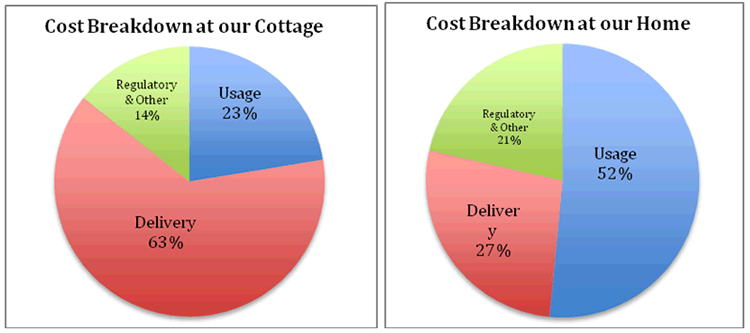
At the cottage, 23% of my electricity bill went back to the company which supplied the electricity to Hydro One for the cost of supplying electricity for my use, while 63% went to Hydro One to pay for all of the lines, transformers and the like used to deliver the electricity to the cottage, and the remaining 14% went to paying for various regulatory charges and taxes. In the case of our cottage our annual usage was about 3000 kWh each year. This cost breakdown would differ greatly if we used our cottage all months of the year, but ours is a seasonal cottage and as such the delivery costs dominate our cottage hydro bills.
Those who operate their cottages year round will find the cost breakdown proportions to be more like those we find in our city home. At our home in the city, we use about 1,100 kWh a month, our usage accounts for 52% of our bill, delivery accounts for 27%, and regulatory and other charges account for the remaining 21%. In the city, our cost per kWh used (or “unit cost”, calculated by dividing the total cost of electricity by the amount used in the same period) is 12 cents per kWh while at the cottage our unit cost is 29 cents per kWh.
When I first calculated the unit costs for our cottage and our home, I was shocked by the difference between them and went back over my calculations to see if I had made an error somewhere. After more careful consideration, I realized that the difference makes sense. Hydro One has invested a great deal of capital in miles of wire and transformers to reach the cottages in my area, with their low annual usage, but it still needs to recover its investment from me (and others) over time and has less consumption from which to do so than in areas less remote where there is more usage. In fact, when I looked at the amount Hydro One receives in delivery charges from my cottage bills on an annual basis (which is the only portion of the bill which Hydro One actually keeps), although a higher proportion of the overall bill than on my city bill, in dollar amount, the delivery portion was almost exactly the same as I paid to my city electricity distributor for its delivery portion.
But, of course, I am interested in bringing the costs that I pay for electricity at the cottage down, if I can. In fact, if I can achieve savings on my electricity use at the cottage, because it is so much more expensive per unit than in the city, those cottage economies will be more valuable to me. So, the next thing I did was examine the rate structure that governs my electricity payments at the cottage.
Conceptually, your electricity bill has two components. The first is the price you pay for the energy that is supplied to you (for 2009-2010, for most cottages, this was 6.4 cents per kWh and If your monthly cottage usage exceeded 600 kWh per month, the charge was 7.4 cents per kWh for the usage over 600 kWh). It is this first component of the bill which will be changing with the introduction of Time of Use [TOU] rates this summer. The second component of your electricity bill covers Hydro One’s costs in delivering that electricity to your cottage. This second element includes a $25 flat fee, no matter how much energy you use, plus a charge of 10.8 cents per kWh for the delivery of the energy to your cottage. Thus, in 2009-2010, the grand total of the variable rate components (leaving aside the $25 flat fee) was 17.2 cents per kWh. This number is quite high and provided me with excellent motivation to begin thinking about ways to conserve at the cottage! But then I remembered Ontario’s roll out of smart meters and the introduction of the Time of Use rates. So, I needed to continue my research investigations!
TIME OF USE RATES ARE COMING
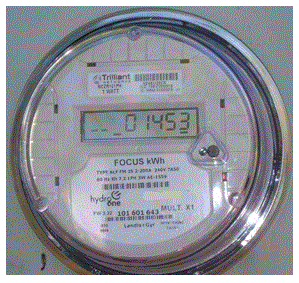 It turns out that the Ontario Government’s Smart Metering Initiative is going to be reaching most of cottage country this summer. In the case of our cottage, two summers ago I noticed that my traditional ‘spinning disk and dial’ meter had been replaced with a meter with a digital display (see Photo). This new meter is a ‘smart meter’. Smart meters work using wireless technology to send hourly energy usage readings back to Hydro One to allow it to bill electricity usage with more precision and to have billing based on the actual time of use of the energy.
It turns out that the Ontario Government’s Smart Metering Initiative is going to be reaching most of cottage country this summer. In the case of our cottage, two summers ago I noticed that my traditional ‘spinning disk and dial’ meter had been replaced with a meter with a digital display (see Photo). This new meter is a ‘smart meter’. Smart meters work using wireless technology to send hourly energy usage readings back to Hydro One to allow it to bill electricity usage with more precision and to have billing based on the actual time of use of the energy.
Local electricity distribution companies, such as Hydro One, have been directed by the Ontario government to install smart metering systems in preparation for the province-wide transition to Time of Use (TOU) electricity pricing. The government has announced that all residential meters will be billing on TOU rates by the end of June 2011. So, for virtually all cottagers, this summer will be the first summer on TOU Rates.
Although Time of Use rates are relatively new to the electricity sector in Ontario, variations of this rate structure have been used for electricity pricing in the U.K. since WWII. In Canada, telephone companies have been using time of use rates for long distance charges for as long as I can remember (when I was growing up, we always used to call our out of town relatives on Sunday!).
Any time a rate structure is changed even if the change is designed to collect the same amount of revenue across an entire class of customers, there will be some consumers who end up paying more and there will be some consumers who end up paying less. The following graphs show the traditional two-tier rate structure of electricity billing in Ontario and the new TOU rate structure in effect for summer 2011.
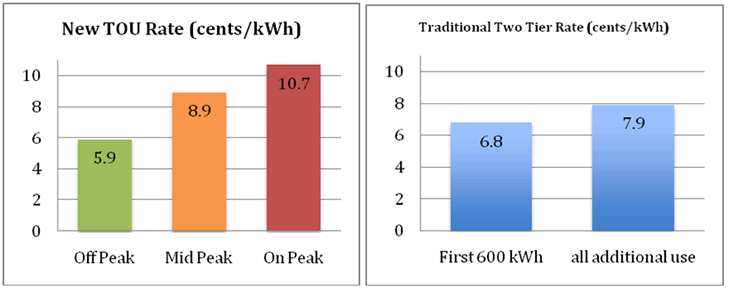
It is important, under the new TOU rate regime, to know when each of the three new rates applies. The Ontario Energy Board (http://www.oeb.gov.on.ca/OEB/Consumers) governs these rates and it has determined that “off peak” will apply to all weekends and statutory holidays and, as well, to mid-week evenings from 7PM through to 7AM. The good news is that this is more than 60% of the hours in the year. “Off peak” is the same all year round. “Mid peak” and “On peak” are different in the summer than in the winter. “Summer” is defined by the Ontario Energy Board as between May 1 and October 31. During the “summer,” “mid peak” is deemed to occur from 7AM to 11AM and from 5PM to 7PM every weekday except statutory holidays. “On peak” is deemed to occur from 11AM to 5PM every weekday except statutory holidays. If you are interested in the “winter” definitions, please see http://www.oeb.gov.on.ca/OEB/Consumers/Electricity/Electricity+Prices.
Returning to the situation of our cottage, then, our monthly fixed charges will remain at about $25 per month this summer (2011), while the variable rate component of our bill, which would be 17.6 cents per kWh (increased slightly from the 17.2 mentioned above due to a recent rate increase) under the old pricing system, will now vary by the time of day of the actual power use between 16.7 and 21.5 cents per kWh.
These new rates are designed to better reflect fluctuations in the actual cost of generation through the day and week in the summer (to better reflect the average supply and demand effects on price). In fact, many experts suggest that the government’s current pricing difference ratio between the on-peak price and the off-peak price is too narrow and believe it is likely that this differential will grow once customers get used to the new rate structure. My thinking is that whatever habits I form now to gain benefits from lower cost off-peak power will provide even greater benefits to us in the future.
It is also the case (based on how electricity is produced in Ontario) that electricity produced and used in off-peak hours is produced with lower average carbon content, so by shifting usage to off-peak we can play a role in reducing province-wide carbon emissions too. I see it as both a budgetary and environmental improvement challenge to take action on reducing our overall usage.
MOVING TO TIME OF USE RATES – AN UNANTICIPATED CONSEQUENCE!
My analysis predicts that the move to TOU rates at my cottage is not likely to cause my bill to rise or fall by more than a dollar or two at the most. I also think that the billing information about our energy consumption that I will receive under the new rate structure will provide us with more opportunities to reduce our costs in the future through controlling and shifting our usage.
For most seasonal cottagers, it appears that the biggest impact of the move to TOU Rate will be on cash flow. Traditionally, Hydro One has taken one reading a year, when the technician visited our meter. However, Hydro One has always billed us four times per year. This means that 3 of the 4 bills were based on Hydro One’s estimates of my usage: the one annual ‘real’ reading allowed Hydro One to correct for error in its estimates which were the bases of the other 3 bills. In our case, our annual “read” happened in late August and formed the basis of the bill that I received in September. Hydro One was extrapolating from that reading as though our cottage had used that energy over 12 months (although the energy usage was actually seasonal). Therefore, in 2009-2010, for example, we received a bill from Hydro One each quarter (in September, December, March, and June) for about $225. The affect of this was like having your seasonal cottage electricity account on an equal billing plan.
When the new TOU system comes into force, and the capabilities of the new smart meters are fully engaged, cottagers will go from having one, on-site, meter reading per year to having 8760 meter readings per year (one each hour): cottagers will be billed for usage at the time of day (and month) the power was actually used. Therefore, once TOU rates are in force, we can expect to receive much higher bills in the summer and much lower bills in the winter periods. For our cottage, my analysis predicts a September bill (for usage in June, July and August) of about $525, a December bill (for usage in September, October, and November) of about $175, a March bill of $75(when the cottage is closed), and a June bill of $125 (for May, after we open up again).
Many cottagers will be surprised by this unanticipated consequence of the changes made to billing by Hydro One, changes it must make in order to comply with the government’s new electricity pricing regime.
STRATEGIES FOR LOWERING ENERGY COSTS AT THE COTTAGE
There are three basic strategies for reducing energy costs, which you may wish to consider at the cottage. The first two have always been possible, but the third becomes possible now with the introduction of TOU rates.
- Use less energy by doing fewer things.This strategy is worth mentioning because sometimes we use electricity when we really don’t need to and doing without it would not cause inconvenience. In our household, an example of this might be leaving lights on when they don’t need to be on.
- Use less energy by doing things more efficiently.This strategy involves using equipment or appliances that are more energy efficient.
- Shifting usage to a time of lower cost.This strategy is the one that is now available to cottagers as TOU rates are introduced.
The first of these strategies often involves training everyone to turn off lights and other equipment when not needed. At our cottage, lights and bathroom fans are sometimes left on: hardware stores are now carrying light switches designed to turn your lights on for a period of time after which the switch turns the lights or fans off automatically. At our cottage, while we have an electric clothes dryer, we have installed a clothesline and are now only using our clothes dryer when it is absolutely needed.
The second of these energy-lowering strategies (creating efficiency) requires some investment. At our cottage, we started with an easy thing first: we replaced all of our light bulbs with compact florescent or LED lights. A major energy user at a cottage is the refrigerator: I would encourage everyone with a refrigerator that is 10 years old or older to consider replacing it. Adding a insulating blanket to your water heater is also an easy step to take to reduce energy loss from this, often overlooked, energy guzzler.
 The third of these cost-reducing strategies may, at first, seem too inconvenient to consider, but perhaps you might begin by considering the addition of a specialized 7-day timer on your electric water which you can then program to only heat (or re-heat) your hot water during the off peak period. The tank can then store the hot water for your use through out the day. For exceptional needs, these timers have an override to allow you to heat your water at on on-peak or mid-peak moment should your need for hot water exceed the storage capacity of your tank on occasion.
The third of these cost-reducing strategies may, at first, seem too inconvenient to consider, but perhaps you might begin by considering the addition of a specialized 7-day timer on your electric water which you can then program to only heat (or re-heat) your hot water during the off peak period. The tank can then store the hot water for your use through out the day. For exceptional needs, these timers have an override to allow you to heat your water at on on-peak or mid-peak moment should your need for hot water exceed the storage capacity of your tank on occasion.
In addition to working on the three strategies mentioned above, you may wish think about installing renewable generation (for example, solar or wind generation) to further displace your usage at the cottage. Renewable generation installation is a topic that needs to be considered all on its own but I mention it here because, if you look into it, you will quickly learn that anything and everything you do to first along the lines of the three strategies suggested above to reduce your usage will make any subsequent alterative generation plan you devise more viable.
TOOLS TO ASSIST YOU WITH ELECTRICITY PLANNING UNDER THE TOU SYSTEM
Hydro One’s website has lots of useful information that will help you better understand your energy use. I encourage everyone to visit the Hydro One site and to register for the free “My Account” service in order to view the electricity usage of your cottage online (http://www.hydroone.com/MyHome/MyAccount/Manage/Pages/home.aspx). Once registered, you will be able to see the “Account Activity” area and, once your cottage is put on TOU rates, there will be an option in the “Account Activity” menu to “View Your Usage History” which is updated on a daily basis by Hydro One. From time to time, Hydro One even has discount coupons for energy savings equipment in this area of the site. The various data views made available here seem very useful. If useful for nothing else, I can see these tools being a perfect way of double-checking whether I have remembered to turn everything off at the cottage at the end of the season and not finding out in the spring that I left a heater running all winter!
The usage view for monthly consumption by time of use periods for a cottage already on TOU rates is shown below.
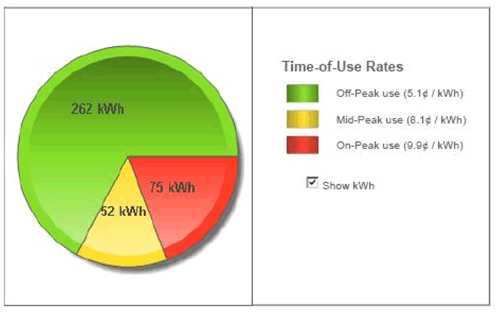
The next image is a daily use chart also available to registered TOU MyAccount users which shows hourly energy usage in the different time of use pricing periods for a given day for a cottage property already on TOU rates. As soon as your cottage is actually being billed on TOU rates, these charts, for your own cottage, will be available for you. I hope that like you, my family will be enjoying the Bay this summer while continuing our journey towards conserving energy dollars…
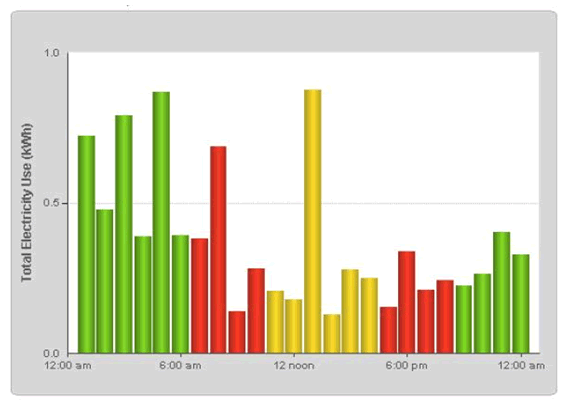
About the Author: Richard Crouch is a Professional Engineer who has worked in the electricity industry for 30 years and runs his own consulting firm ODYNA Inc. He can be reached at odyna@rogers.com.

